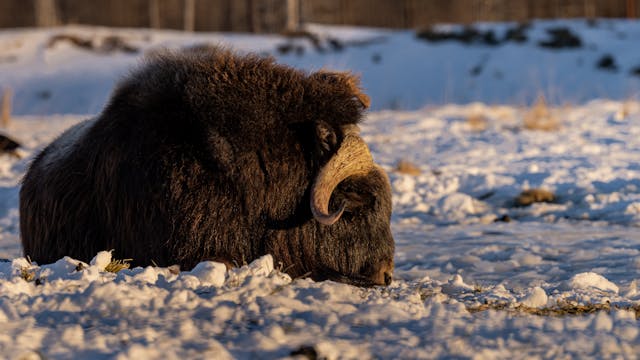
Why are muskox invisible to satellites? Muskoxen are invisible to heat detection cameras on satellites because they are extremely well insulated by their fur.
Muskox are called muskox because of the smell the males produce during mating season. They have a gland called the preputial gland which produces a strongly scented fluid. The preputial glands are just below the eyes of the muskox and they can wipe it on their legs and all over the outer surface of their fur coat. The scent is very musky, strong and pungent. It is evolved to be very noticeable, so it is not a pleasant scent. Muskoxen have an incredible sense of smell as well, so they can detect the scent over long distances. They are not territorial, but they use the scent to mark routes and the area that they are grazing in.
Muskox are famous for their coats, which is the reason why they don’t show up on infrared heat cameras on satellites. In the Inuit language, they are called “omingmak”, which means the animal with skin like a beard. They are covered in a very thick hair. They mostly live in northern Canada, near the Arctic and in Greenland. These areas are very cold and generally have permafrost. The temperature in these areas can drop to -40℃, and sometimes even lower. Without excellent insulation and a few other tricks, there is no way that muskox would be able to survive. They have their coats, they have a different type of hemoglobin, and they can shut off parts of their bodies.
Muskoxen have two layers to their coats. An outer layer full of guard hairs and an inner, shorter layer that is the main insulation in the winter. When the weather is warmer, they lose the inner layer. The outer layer has long hair that reaches to the ground. These act like an overcoat and protect the muskox from rain, wind, and snow. The secret to their warmth comes from their inner coat, which is called qiviut in the native language of Alaska. It is the lightest and warmest natural wool made by any animal. Qiviut is 8 times warmer than sheep wool. Qiviut is made up of many small fibers. The fibers in qiviut are generally 15 micrometers in diameter, while cashmere is 19 micrometers. For comparison, a human hair is about 100 micrometers across. The hairs are tiny and there are a lot of them. They tangle together and form a mesh that is very light, very dense, and very good at trapping warm air next to the muskox’s skin. The wool is so good at keeping heat in that when you look at a herd of muskox with an infrared camera on a satellite, they don’t show up.
Muskoxen have two other adaptations to the extreme cold. The first is their hemoglobin. Hemoglobin is the molecule in blood that binds with oxygen to carry it around the body. It only works at certain temperatures. If it gets too cold, the hemoglobin doesn’t work. That is one reason why octopuses don’t use hemoglobin and have blue blood. The hemoglobin that muskoxen use is three times less sensitive to low temperatures than ours is. That means, even in very low temperatures, they can still transfer oxygen around their bodies. The other ability they have is the ability to shut off heat regulation in their legs. Animals that can do this are called heterothermic. We are not able to do that. Our whole body has to be kept at a specific temperature and if we wore a warm coat but had naked legs, we would still lose heat because our body would try to keep everything the same temperature. Muskox can lower the temperature of their legs so that the body doesn’t lose heat trying to keep them warm. A lot of birds can do this as well, which is why penguins don’t get stuck to the ice they are standing on.
Muskox fur is very sought after for clothing, and they were almost hunted to extinction for it. Luckily, laws were put in place and now they are a protected species. The only wool that can be sold is wool that they naturally shed when the weather gets warmer and can be found tangled on bushes. It is hard to find, which is why clothes made of muskox wool are so expensive. And this is what I learned today.
Sources
https://www.nationalgeographic.com/animals/mammals/facts/musk-ox
https://en.wikipedia.org/wiki/Muskox
https://en.wikipedia.org/wiki/Heterothermy
https://cdnsciencepub.com/doi/10.1139/z89-163
Photo by Ryan Noeker: https://www.pexels.com/photo/musk-ox-sleeping-in-a-snowy-glade-19491672/
